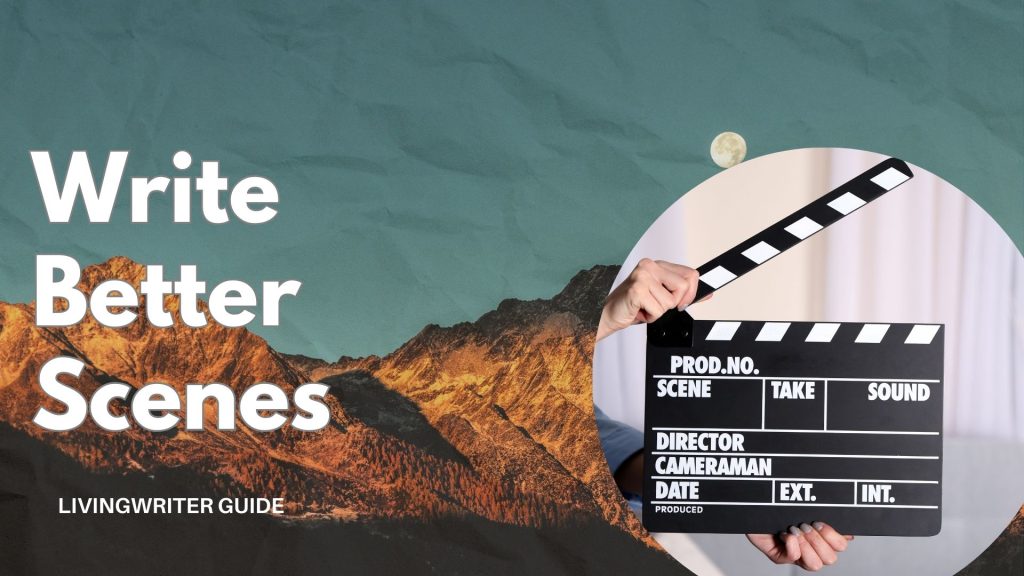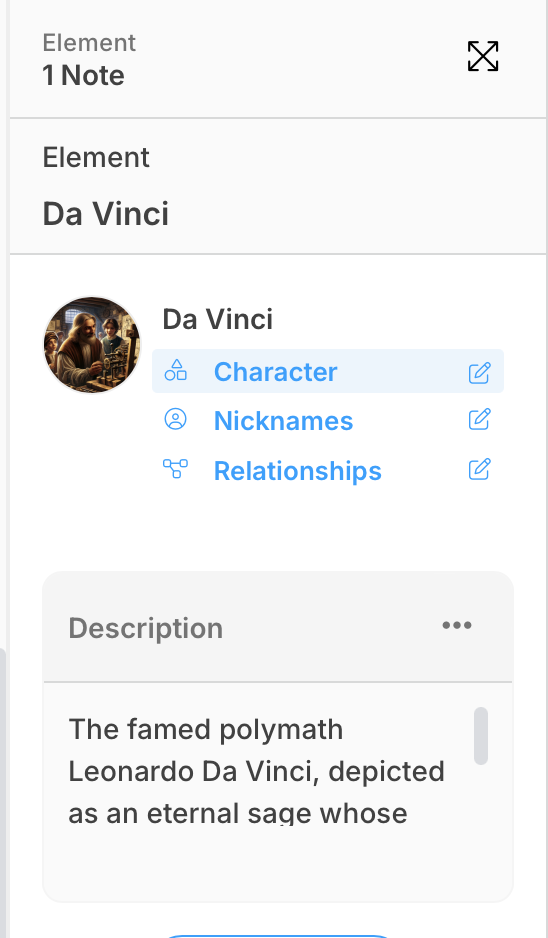How To Write A Scene – 10 Great Tips

There is a lot of info out there on how to write a novel and step-by-step guides to writing a screenplay, which are great. A lot goes into writing a whole book, and looking at it as a whole isn’t bad. But on the flip side, there is immense value in going a few layers deeper into the individual scenes that make up a story and practicing there, too.
In today’s article, I’ll share 10 tips for writing better scenes, collectively known as the “Lamb Method.” They were created by writer Nancy Lamb, and they’re all very practical. Not only do they give you actionable advice, but they also illustrate the concepts of the purpose of a scene. So, without further ado, let’s get started learning how to write a scene.
Table of Contents
How To Write A Good Scene
First, I want to briefly explain why scenes are important and how they’re used.
Scenes are the fundamental building blocks of both novels and screenplays that propel the narrative forward. Whether described in lush prose or captured through cinematic visuals, scenes are where characters come to life, conflicts erupt, and emotions resonate—or at least they should.
That’s the lesson that I hope to teach by the end of the article – Scenes should always have a purpose in the grand scheme of the story, and you should know what it is. If at any point you find that you could delete a scene and the story as a whole wouldn’t change, you need to rewrite or delete it.
By giving each scene a purpose, you elevate your entire work, transforming a collection of events into a captivating and immersive experience for your audience. A well-written scene isn’t just a snapshot of a moment; it’s a microcosm of the larger story, driving the plot, revealing things about the characters, and keeping the audience right where you want them.
1. Avoid Dead End Scenes

A scene should lead to something else that the reader wants to read. A dead-end scene is when that doesn’t happen. Basically, the scene doesn’t fuel the story. The audience/characters enter the scene and then come out the same, and that’s no good.
To fix this, use some number of these three “forwarding” devices:
- New Information: This is information that the reader (and often the characters) didn’t know before. It could be a secret, a clue, a piece of backstory, or any other detail that changes the reader’s understanding of the situation and moves the plot forward. It creates questions or shifts the direction of the narrative.
- A Decision Made (But Not Acted On Yet): Focus on a character making a significant decision within the scene, even if they don’t immediately carry it out. The decision itself creates tension and anticipation as people wonder when and how the character will act on it and what will happen. This sets up future actions and consequences.
- A New Complication: This involves introducing a new problem, obstacle, or conflict that the characters must now deal with. This could be an unexpected arrival, a sudden change in circumstances, or the revelation of a new threat. It raises the stakes and creates new challenges for the protagonist.
If one or more of these devices is present in a given scene, then you know it has a purpose beyond simply depicting a moment in time.
2. Two Steps Forward, One Step Back

Sometimes, of course, certain scenes will resolve issues. This is perfectly fine, but there are a few things to consider. First, you don’t want to take your foot off the gas much. Every time something is overcome or figured out, add another thing.
However, you can’t simply randomly throw in a new problem to replace the last one. When you add new elements, try to do it in a “because of that last thing, this happens” rather than a long series of “and then, and then, and then…” situations that may cause readers to feel strung along.
This ensures that people know where the story is going and stay interested. So, I like to think of this as an ever-evolving problem.
3. Maintain Credibility

Sometimes, stories go well, and then something happens that doesn’t feel right, and it loses you. Some event or act feels like it goes against the grain of everything that’s happened so far. You’ll know what I’m saying if you’ve experienced a story break credibility.
As an author, you’re responsible for telling the reader what is and isn’t possible and what is realistic for your story. And you don’t want to do too much out of the blue, go off the rails, and lose people – So, how do you keep things plausible? You warm them up by setting the story and foreshadowing.
An example I like is Stranger Things, with the character Eleven and her psychokinesis. When we first start seeing her use her powers, it’s unintentional, at times when she’s stressed. Eventually, she starts to have control and can use them for small things. Then, much later, only after we’ve seen this, do we really start seeing her do crazy things.
This setting of the tone for the world is important for viewers. If Eleven had been flipping buses right from the start, it wouldn’t have felt nearly as credible and realistic as it did when properly foreshadowed. So, keep this in mind in your scenes, and don’t throw people into the deep end with things you haven’t made them aware of.
4. Use Character Motivation

When writing a scene, stop and ask yourself, “Why are the characters doing what they’re doing in this scene?” The answer should be linked to their own motivation versus just moving the plot along. You should understand what your characters want, what they don’t want, and why, and keep it in mind.
You May Like: Write Better Characters And Plots – 5 Tips
Disguised motivation that the readers don’t understand works well too. As long as you know that you’re letting your characters act in a way that is consistent with their wants and needs and character arc, your scenes will have more authenticity.
5. Cause And Effect

You want your scenes to have some cause and effect to them. This way, there are consequences for the characters actions. Without a clear cause and effect, events feel arbitrary, disconnected, and less interesting.
The story gains a sense of purpose and direction when every action has a consequence and results from preceding events. This creates a more immersive and satisfying reading experience for the audience.
A bonus tip here is to try some unusual things. All too often, in real life, the things we do have unforeseen consequences on those around us. So, don’t be afraid to play around with cause and effect from different characters’ POVs and take unexpected angles.
6. Keep Your Eye On The Goal

So far, we’ve been talking about things that a scene should do on an individual level. For this tip, we’re going to step back and make sure that these wonderful scenes we’re writing are still functional in the big picture, too.
In other words, does this scene get the story closer to the end? If you can delete it and the story be the same, maybe take it out or revise it. Obviously, scenes can serve purposes beyond the main plot progression (character development, back story, etc); however, most should directly move the story along.
7. Remind The Reader Of The Conflict

Similar to the tip above, you want to make sure your scenes don’t let the reader forget the central conflict. Be conscious that you aren’t “taking chapters off” exploring sub-plots or new characters without pretty quickly tying them into the main conflict in some way.
8. Conjure Interesting Problems

This tip refers to minor, scene-based problems rather than plot-level issues. Be unique with these smaller things that arise between the more significant conflicts. Let’s say your character is a milquetoast teacher who decides to murder a rival. That’s a big conflict.
Some scene-based conflicts that could arise from this situation could be: How does a docile teacher get a gun that isn’t traceable? How does he learn to load a gun he’s not supposed to have without telling someone he’s got it? Perhaps he gets pulled over for something completely unrelated and has to deal with the police. Maybe he gets a flat tire.
Whatever scene-based problems you choose to throw at your characters, don’t always solve them in the same scene. If you can stretch them just a bit, even a scene or two later, it creates some fantastic tension.
9. Up the Stakes

Speaking of tension, don’t let your foot off the gas too often or for too long. As you get further into the story, don’t let the stakes die down. Simply put, the advice here is always make things worse. Let’s use our vengeful teacher example again.
Once he hardens up and turns into someone capable of killing his rival, things can’t just get easier for him. Whether someone tips the rival off or he gets arrested and thrown in jail, making him impossible to reach, something should always come along and escalate the situation above and beyond the current level.
10. Use Less Characters

Sometimes, with scenes (just like everything else), less is more. So, with all the tips I’ve just given you in consideration, don’t be afraid to keep it simple. One easy way to do this is by reducing the number of characters in a “crowded” scene.
Ideally, readers should have a pretty clear idea of which character(s) the scene focuses on. If you notice this starting to get muddy, take a few characters out of the scene, if possible. If they’re background characters (like the waitress in a cafe), consider leaving them nameless so readers don’t have to keep up with them.
Writing With LivingWriter
LivingWriter is more than a simple word processor. It’s a comprehensive writing environment designed to enhance the entire creative process. By integrating powerful character development tools, robust outlining capabilities, and even AI assistance, LivingWriter empowers writers to craft better, more compelling scenes.
Here’s how you can elevate your scenes with LivingWriter.
Character Depth
LivingWriter’s character elements encourage you to delve deep beyond basic traits. You can record their motivations, fears, relationships, and even physical quirks. This level of detail translates directly into more nuanced and believable character interactions within your scenes.
Simply typing the name of a character into a scene will pull it into the manuscript like a link. With a click, you can view all of the character’s info, nicknames, or notes you’ve added without switching tabs.

Access to these character profiles acts as a constant reference, helping you maintain consistency across your entire story.

Enhanced World-Building
You can seamlessly integrate these details into your scenes by meticulously documenting your world’s history, geography, and inhabitants within LivingWriter. For example, a character’s dialogue might subtly reflect their cultural background or the unique climate of their location.
You May Also Like: Fantasy Worldbuilding Like George R.R. Martin
Plot Point Refinement
LivingWriter’s outlining tools allow you to visualize the overall plot arc and identify potential plot holes. You can ensure a more logical and engaging narrative flow by meticulously mapping out cause-and-effect relationships between scenes.
Conclusion
There you have it, my friends; you now know how to write a scene (and do a good job) using the Lamb Method. When every scene in your story introduces new complexities, moves the story forward, and makes the reader want to read what happens next, you’ll have a very strong story indeed. So, get out there and get to writing.